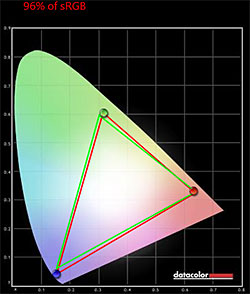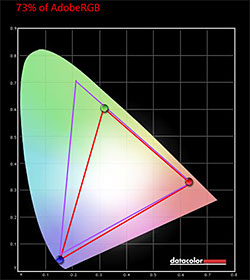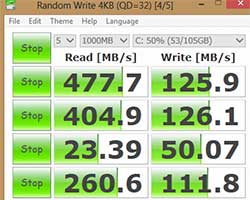Display and Pen
Like the Duo 11, the Duo 13 has a full HD IPS display that works with touch and the included N-Trig digital pen. The pen has a metal casing and is a bit longer than the Duo 11 pen (that's a good thing). It's powered by a single AAAA battery that the manufacturer states will last a year, though I've found 6 months is more like it if you frequently use the pen. The pen has two buttons on the side and no eraser up top. Button function varies by application--for example one of the buttons acts as the eraser trigger in ArtRage. Sony provides a plastic clip-on pen holder for carrying the tablet and pen together, and there's a pop-out ink well pen stand on the right side.
The display is the same 1920 x 1080 Triluminos panel used in the Vaio Pro 13, and it's simply superb with a very wide color gamut, high contrast and good black levels. At 265 nits, it's not wildly bright, but it's more than adequate for indoor use and is indeed brighter than non-premium laptop displays. The panel achieves an excellent 96% of sRGB and a very good 73% of Adobe RGB, making it well suited to graphics work. Honestly, as with the Pro 13, movies simply look better than on other laptops and I found myself watching less than stellar content just for the pretty scenery.


The pen story isn't compelling if you're an artist, but it's all great news for note takers. The pen tracks quickly and accurately with none of the chronic offset and frequent recalibration requirements we've suffered on the latest Wacom-based Windows tablets like the MS Surface Pro, Lenovo ThinkPad Helix and the Samsung ATIV 700T. The N-Trig digitizer with DuoSense2 pen with palm rejection and pressure sensitivity inks smoothly and reliably right up to the edges of the screen. The pen sampling rate is definitely improved from the Duo 11, and even rapidly drawn circles aren't a problem. For note taking and writing equations as well as diagraming, it's fantastic. The pen works wonderfully with MS Journal and Outlook 2013. For those who are technically minded, the pen sampling rate is 133 PPS, and it supports 256 levels of pressure sensitivity, which is lower than recent Wacom equipped tablet PCs with 1,024 levels of pressure sensitivity.
Many digital artists know that Adobe has yet to release WinTab drivers for N-Trig for use with Adobe Photoshop, Corel Painter and Paint Tool SAI, and I wouldn't hold my breath: that means no pen pressure sensitivity in those programs (at least not until Adobe switches to the newer Windows Ink APIs, perhaps by year end). But programs that use the more modern Windows Ink APIs like SketchBook Pro, ArtRage and Outlook 2013 do have pressure sensitivity. Sony bundles ArtRage Studio Pro 3.5 and Note Anytime for Vaio that launches if you remove the pen from its side-mounted clip (you can disable auto-launch). Oddly, ArtRage, which uses the Windows Pen API and works fine on other N-Trig equipped tablets like the Vaio Duo 11 and Asus Taichi 21, doesn't work well (it's doubly odd since the program is bundled). The pressure curves are wrong with the thinner and lighter tools like the pencil tool making lines so faint they're hard to see. The paintbrush acts like a pen and the airbrush tool requires extra passes to cover the canvas. ArtRage is a very capable natural media drawing and painting program, and without it, I feel a little lost since Photoshop with pressure sensitivity is out of the question. Manga Studio 5 would be a great fallback, and it has pressure sensitivity on N-Trig tablets like the Vaio Duo 11, but on the Duo 13 there's no pressure sensitivity. Will the required parties fix this? I can only hope so. Ambient Design, makers of ArtRage said they're looking into it so there's definite hope. We've contacted the makers of Manga Studio 5 and will report back when we receive info.
Keyboard and Trackpad
The Duo 11's fairly miserable pointing stick was saved largely by the touch screen (you could run screaming from the pointer and use touch instead). Thankfully, Sony abolished that space-saving but frustrating piece of technology on the Vaio Duo 13. Instead a half-height Synaptics buttonless trackpad provides very usable navigation when you don't want to touch the screen. It's quite short, so there's not much room for multi-touch gestures like pinch-zoom, but we found it worked fine for swipe gestures and two-finger scrolling.
The Duo 13 is now a viable text entry tool for those who write at length, though key travel is short and feels a bit jarring on the fingers. I wouldn't call it a writer's keyboard, but it's certainly adequate for those who don't make their living as I do, pounding out tens of thousands of words per week. Even if you do write at length, the keyboard isn't bad by any means; it's simply not as comfortable in terms of key travel and tactile feel as the Sony Vaio Pro 13 or the Lenovo ThinkPad Helix keyboard. An ambient light sensor controls the keyboard's backlight, and you can adjust duration, and even have it on all the time if you like, but you can't control brightness manually. The backlighting is a bit uneven and the LEDs glare out from the edges of a few keys, and that's more noticeable on the white edition. There's almost no illumination under the arrow cluster and the 9 key is dimmer than the 7 key (watch our video review to see for yourself). We looked at a few units and they were all identically uneven, so it's a design issue rather than a one-off flaw. It's not a deal breaker, but we expect better on a high end machine, and the less expensive Vaio Pro 13's backlight is perfectly even.
Performance and Horsepower
The base Duo 13 has a 1.6GHz Intel Core i5-4200U CPU with Intel HD 4400 graphics, 4 gigs of RAM and a 128 gig SSD. We have the 1.8GHz Intel Core i7-4500U with 8 gigs of RAM and a Samsung-made 128 gig SSD for review. It has Intel HD 4400 graphics rather than the more expensive Core i7-4650U with HD 5000 graphics, yet it's surprisingly quick in the graphics department. Granted, there are few Haswell Ultrabooks on the market to compare it with right now, but graphics benchmarks are significantly higher than the Sony Vaio Pro 13 with the same graphics chip and Haswell CPU, and it beats the HD 4000 in Ivy Bridge third generation Ultrabooks and convertibles by a significant margin. That translates into very good Photoshop performance, smooth HD and 4K video playback and the best experience we've had yet playing Civ V at full HD resolution and 60Hz refresh on an Ultrabook or tablet with integrated graphics. Nice. Now we're still talking integrated graphics, so don't expect to play BioShock Infinite at native resolution and medium settings. But older and less demanding games are playable, often at native resolution.
Sony has actually made good use of Intel's cTDP (configurable thermal design power), and there are two power profiles: one for laptop mode and one for tablet mode. In laptop mode when plugged into power, the Vaio Duo 13 can actually run as high as 25 watts (17 watts is the normal top end for ULV Haswell); hence the very good graphics numbers we saw in 3DMark 11 and in practice when playing Civ V. When in tablet mode, it behaves something like a Y series Intel Core CPU and it drops the voltage down considerably for cool and quiet operation. Lovely. When in laptop mode unplugged, it runs at the standard 17 watts max.
The machine's DDR3 1600MHz LPDDR RAM is soldered to the motherboard, so you can't upgrade it. Our 8 gig model's RAM is configured in dual channel for better performance. It uses a standard mSATA SSD drive (ours was made by Samsung) rather than the super-fast new PCIe SSD drive used in the US Sony Vaio Pro Ultrabooks. As with the Vaio Duo 11, this isn't an easy machine to open up, so I'd advise ordering it with the RAM and SSD capacities you want rather than planning a do-it-yourself SSD upgrade later.
Benchmarks
(1.8GHz Intel Core i7-4500U, 8 gigs RAM and 128 gig SSD)
PCMark 7: 4800
3DMark 11: P1072 (performance, 720p test setting) 948 graphics, 3618 physics
wPrime: 19.16 sec.
Windows Experience Index:
Processor: 7.1
RAM: 7.6
Graphics (for desktop): 5.9
Gaming Graphics: 6.5
HDD: 7.7
PCMark 7 Benchmark Comparison Table
CrystalDiskMark SSD Scores

Facial Recognition that Actually Works, and a Great 8MP Rear Camera Too
We've seen many notebooks and even smartphones with facial recognition through the front camera, and to be honest that feature was often slow and it failed in low light. The front 2MP camera with Exmor R sensor works extremely well in conjunction with the FastAccess facial recognition software when logging into Windows 8. It's quick, manages in low light and it will temporarily switch to a white background to increase lighting to your face as needed during the recognition phase. In good lighting, it takes only a second or two, and in very low light it takes 3-5 seconds. The camera works well with Skype for video chat.
The rear 8MP camera with Exmor RS sensor is a rare gem among Windows tablets. While some mobile OS tablets have decent cameras these days, Windows tablets rarely go above 5MP and their sensors and software are mediocre. Sony's camera can actually shoot very good photos and 1080p video with good lighting (there's no flash). Images in well lit indoor environments and outdoors rival those of an 8MP camera phone. Granted, most of us won't wave a 3 lb. tablet around to take photos and video, but for business and vertical market use it could be a strong value-added feature. The camera is located on the rear toward the right side when held in tablet mode. In laptop mode it faces the desk, so you can only use it in tablet mode. Sony includes ArcSoft Camera for Vaio and it takes better photos than Microsoft's basic camera app, and it has more features. They also include CamScanner, which turns your Vaio into a document scanner, complete with OCR.
Battery Life
Wow, really, battery life is that good. Sony claims up to 10 hours of actual use time from the 6230 mAh Lithium Ion battery that's sealed inside, and they're not exaggerating. In a mix of laptop and tablet style use, we averaged 9 to 10 hours. Tablet mode runs at lower power, so you'll get longer runtimes if you use it more as a tablet, and if you use it in laptop mode while playing HD video, you'll get less. The Intel Haswell CPU is much more power frugal than the outgoing Ivy Bridge, and it shows here. It helps that Sony increased battery capacity from the Duo 11 and the 13 Vaio Pro. Those of you who want a Windows machine but were tempted by the 2013 MacBook Air with Haswell because of its long battery life should be interested in the Duo 13. The tablet ships with the same compact charger with a USB charging port for your smartphone or tablet as the Vaio Pro models. Unlike the Duo 11 and Vaio Pro, there's no optional sheet battery, likely because runtimes are already sufficient to make it through a work day and more.
Wireless
The convertible tablet has dual band Broadcom Bluetooth 802.11b/g/n that worked reliably in our tests. We suffered no dropouts and even at 25 feet from our Airport Extreme N router on the 5GHz band, the Vaio managed full speed according to speedtest.net (we have 25Mpbs up and down via FIOS). We did note that the transmission speed as reported by Windows would bounce from 300Mbps to 24 to 108 as we moved closer or farther from the router, affecting internal network transfers between PCs and streaming HD video, which sometimes dipped to lower quality then recovered. On the 2.4GHz band, which has longer range, we saw higher connection speeds and no loss of video quality when streaming. Though the Vaio Duo 13 can connect to networks that are farther away, the Vaio Pro 13 with Intel WiFi managed higher transfer speeds.
Bluetooth 4.0 +HS is also included and it worked well with Bluetooth mice and speakers in our tests. The tablet has NFC and the transmitter is located on the back--what sadist designed that? There's nothing like holding a 3 pound tablet in one hand while holding your NFC equipped smartphone in the other and trying to make physical contact while also interacting with the screen to accept a file transfer. Oye!
If you build to order, you can get AT&T 4G LTE built-in with a micro SIM card slot located on the back of the display panel. It is locked to AT&T and I've heard no info on getting it unlocked for use with other providers.
Conclusion
As is often the case with Sony, we've got a groundbreaking great product that's not perfect, but it's so much closer than the Vaio Duo 11. Unless you're a digital artist, there really isn't a single fatal flaw. Quite the opposite, in fact: the machine is very fast for an Ultrabook thanks to Sony's use of cTDP to bring up performance above and beyond many Ultrabooks that don't surpass the 17 watt CPU power ceiling, the full HD display is one of the best on the market and the tablet has so many features that this review is absurdly long. Though not a professional writer's dream, the keyboard is quite usable and it has our beloved backlighting, the abbreviated trackpad gets the job done and facial recognition logon actually works. The rear camera is very good, and while we have some quibbles with 5GHz WiFi throughput at a distance from the router, it doesn't drop connections and the 2.4GHz band works fine. The active digitizer and N-Trig pen track accurately with no offset or lag. It's great for note taking, but until we get proper pen pressure sensitivity in Manga Studio 5 and ArtRage, it's tough going for artists. And battery life and noise levels? It's a dream.
Price: Starting at $1,399
Website: www.sony.com
Related:
Sony Vaio Duo 11 review
Sony Vaio Flip 13 Review
Sony Vaio Duo 13 vs. Sony Vaio Flip 13 Comparison Smackdown
Sony Vaio Pro 13 review
Samsung ATIV Book 9 Plus review
13" MacBook Air mid-2013 review (Haswell)
Microsoft Surface Pro review
Microsoft Surface Pro 2 Review
Asus Taichi 21 review
Samsung ATIV 700T review
Asus Transformer Book TX300 review |

